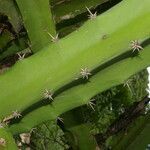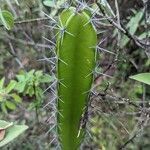Plants clambering or arching-reclining or sometimes tall and columnar, branched near base, sometimes with well-developed trunks. Stems to 5 m long, 6–8 cm diam., little-jointed, 3-angled (4-or 5-ridged on juvenile plants); margins coarsely crenate. Areoles 2–3 cm apart, grey. Spines 4–7, radial, 2–40 mm long and 1 or 2 central spines 15–50 mm long, brown, becoming grey with age, needle to awl-like, very variable. Flowers 15–25 cm long, 8–10 cm diam.; pericarpel and hypanthium with areoles bearing spines and brown wool; petaloid lobes white. Fruit ovoid to obloid, 3–8 cm long, 2.5–7 cm diam., slightly tuberculate, red; pulp pink. Seeds 3–4 mm long, black.
A tall cactus. It forms columns. It can be 5 m high. The branches are dark green. They are 6-7 cm across. There are 3-5 angular ribs. There are groups of spines 2-3 cm apart. These spots are greyish. There are 6-8 spines in a ring and they are 1-2.5 cm long. There are 1 or 2 central spines 4 cm long. The flowers are white with greenish outer segments. The flowers are 20 cm long. The flowers open at night. The fruit are bright red and shiny and can be round or oblong. They are about 5 cm long. The flesh is juicy and red with many small black seeds.



